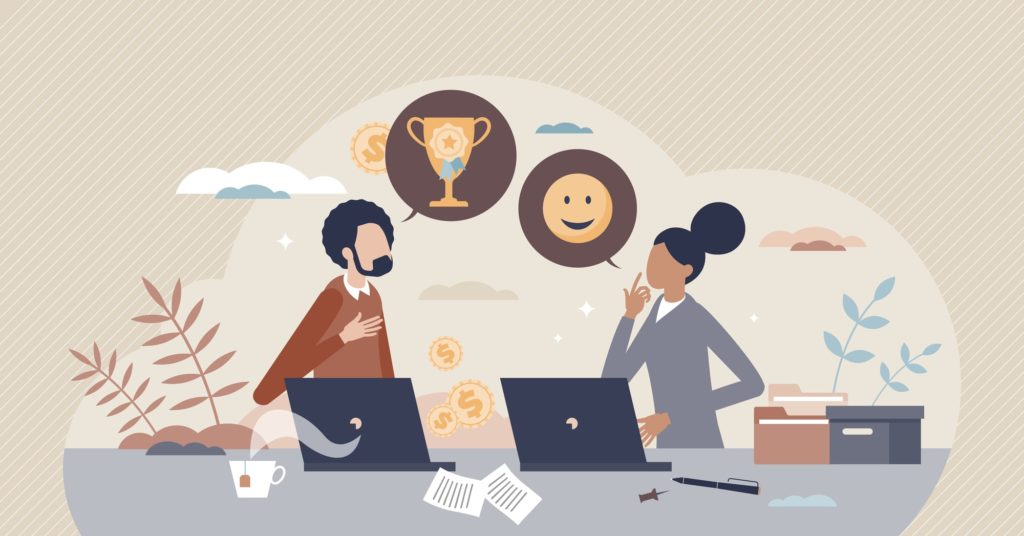Education is evolving to allow for distance learning and hybrid formats alongside the traditional face-to-face model. Higher educators are challenged to adjust to different ways of teaching while also managing the many distractions available to students. As educators seek to manage their productivity, they’re also seeking to maintain student focus and motivation.
To engage students and support their learning experience, both intrinsic and extrinsic motivational strategies can come into play. This article will provide background on both types of approaches. It will offer suggestions for motivating higher education students in a hybrid environment. Finally, it will guide you on deploying extrinsic strategies to engender intrinsic motivation.
Motivating students in person and online
Intrinsic motivation occurs when the individual experiences personal gratification. This satisfaction can be an intellectual interest, an emotional need or a sense of pleasure. The intrinsically motivated student is driven by their need for autonomy and a sense of competence. An external reward causes extrinsic motivation. Students who are motivated extrinsically respond to incentives of grades, praise or awards.
Such motivators may take different forms depending on whether teaching and learning occur in a face-to-face or remote environment. With distance learning, students might not have in-person interaction with peers and instructors. This approach can be challenging for educators, making it more difficult to maintain motivation without the benefit of being physically present with their students.
The hybrid learning model, where students learn through a combination of in-person and web-based learning, presents opportunities to explore diverse sources of motivation.
What does the research say?
The study Student Motivation to Engage in Blended Learning makes a case that gender, age and ethnicity impact motivation differently for learners in hybrid learning environments. According to the study, “instructional design and strategies, instructor feedback and collaborative learning positively enhanced students’ intrinsic motivation to engage in blended learning.”
But not all learners are motivated in the same way. Educators widely agree that intrinsic motivation is more effective than extrinsic motivators. But there’s an opportunity to deploy a balance of intrinsic and extrinsic motivators to help students develop an innate drive to learn. Educators can better position themselves to help students thrive by tapping into internal and external motivators.

Motivation in hybrid classrooms
As the learning landscape changes, educators must contend with increasing sources of distraction available to students. However, the outlook is positive. Sixty-nine (69) percent of the 2,798 undergraduate students who participated in Top Hat’s December 2021 survey agree their instructors excite them about learning – no small accomplishment in the face of uncertain times. Roughly the same percentage (70%) report feeling engaged and motivated in their courses. Three out of four say their instructors provide timely, helpful feedback (73%), along with the flexibility they need to be successful academically (74%). While perhaTo support learning, focus on shifting towards relationships and strategies that motivate students and keep them engaged. Here are 10 suggestions to encourage students, whether in person, online or in hybrid formats.
1) Make space for student autonomy
Give students ownership over their progress and opportunities for choice in their learning. Enable them to seek learning opportunities that are meaningful to them personally. A digital portfolio enables students to archive and share their work and motivates them to build on their accomplishments.
2) Help students believe in their competency
Build up students’ belief in their competence by setting a clear path of expectations. Create a series of achievable benchmarks that enable them to progress. Provide support and formative feedback. Use interactive digital tools to engage and provide feedback to students. While critique may be seen as an extrinsic form of motivation, giving honest and balanced feedback can speak to the student’s internal drivers.
3) Link content to students’ goals
Relating the content to a student’s personal and career goals will empower you to create a relevant context for their learning content. It may also help you identify potential pain points in their progress and prepare you for any trouble spots in the course. There are encouraging signs that one of the lasting effects of the pandemic has been a shift to more flexible and student-centric approaches to teaching that include a greater focus on preparing students for success outside of college. Eighty-six (86) percent agree they are developing transferable skills while 72 percent say their instructors help them understand how what they are learning will support their career readiness after college. Overall, eight out of 10 believe they are gaining the skills and knowledge to succeed in the workplace.
4) Check-in with the students
Elicit students’ reflections regarding course content. A digital approach may enable less assertive students to share their perspectives. A simple Google Forms survey is an easy solution. A presentation tool with polling capabilities will let you take the pulse of the class in real-time.
5) Relate content to relevance in the world at large
Connect the content they’re learning with real-world situations. Invite guest speakers either in person or via web conference to discuss their relationship to the course content. Top Hat’s dynamic courseware can customize textbooks, enabling professors to update in real-time to provide content that their students can relate to.
6) Opportunities for engagement
Set virtual office hours when you can be available for chats or video conferences to answer student questions and clarify complex course concepts. Provide opportunities for students to collaborate or engage in discussion either in person or online.
7) Foster an environment of fair play
To gain the sense of satisfaction that supports intrinsic motivation, students must believe that you will regard their efforts and achievements equitably. Avoid any appearance of bias or unfairness. Invite students to provide feedback on their experience in the learning process.
8) Include an element of surprise
You should present information in surprising ways to maintain attention. Whether in person or online, you can use technology or dialogue to give new information in a way that’s visually or intellectually unexpected.
9) Break with routine
Mix things up to prevent boredom that arises from structure and routine. Gamification is a stimulating way to work with content that students might find dry or rote. The competition aspect of gaming is more akin to an extrinsic motivator, but the spirit of play will stimulate students at an intrinsic level.
10) Set challenging but achievable goals.
If the material taught is too easy, then students will likely achieve the highest level of mastery—but their full potential of growth may be hindered. Keep students’ interest by making the material difficult enough. Maintain motivation by keeping the goals achievable.
Dos and don’ts for extrinsic motivation

Extrinsic motivation is losing popularity, as studies have revealed that it’s less effective for learning over the long term. However, there are ways you can use extrinsic incentives to tap into a student’s intrinsic sources of motivation.
Here’s how you can reorient the following four traditional extrinsic motivators to engage a student’s intrinsic motivation.
1) Grading
Don’t: Use the fear of bad grades as a motivator.
Do: Provide frequent feedback to students as a chance for them to improve throughout the course continuously. Grading based on the total number correct on a sheet can be an artificial measure of learning. Instead, use grading systems that incorporate more authentic standards, such as performance assessment rubrics. A grade will become more meaningful when it taps into an intrinsic source rather than being entirely an extrinsic reinforcement.
2) Rewards
Don’t: Give students rewards.
Do: Help students understand that their face-to-face or online learning experience can be truly rewarding by showing them how to put what they’re learning from theory to practice. Use scenarios with real-world applications that help your audience relate to the content.
3) Extra credit
Don’t: Use the carrot-and-stick method.
Do: Any extra credit assignments should be voluntary and only reward those who complete them. Students who choose not to complete the work shouldn’t lose points.
4) Homework passes
Don’t: Penalize students who don’t complete their reading or homework assignments.
Do: Design the syllabus with a built-in reward. Set the reading schedule to leave spare time at the end of the course. You can reward students who keep to the plan with free time. Those who need the extra time will have it.
Motivate students in the classroom and online
Educators widely agree that intrinsic motivators are more effective for achieving learning success, but extrinsic motivation also has valid applications. Extrinsic motivation is most effective when it aligns external incentives to the student’s psychological needs for independence and accomplishment.
![Intrinsic vs. Extrinsic Motivation: 10 Tips to Increase Motivation in Hybrid Classes [PLUS: Free Hybrid Teaching Toolkit]](https://tophat.com/wp-content/uploads/Blog_IntrinsicExtrinisicMotivation.jpg)

